Fantasy stories are only limited by the imagination – and there are so many subgenres in this expansive genre of fiction that it can make your head spin.
As an author, you need a good understanding of the genre you’re writing in. Not only will this help you with the writing process – knowing the conventions you’re aiming to work with – but, eventually, this knowledge will help you market and sell your book, since categorisation is important in helping match the right readers to the right books.
High fantasy/epic fantasy
In my earlier blog post ‘What is Speculative Fiction?’, I talk about fantasy as being the purest form of spec-fic. Now I’ll go even further: I believe high fantasy is the purest of the fantasy sub-genres.
So what is it? Well, high fantasy is set in a world unlike our own. This world runs by very different rules, but they are rules that make sense and can be relied on. The epic comes into play because supernatural beings tend to be a normal part of everyday life in high fantasy.
Of course, the granddaddy of high fantasy is JRR Tolkien, especially his Lord of the Rings trilogy. But it’s worth turning to Ursula K Le Guin’s Earthsea series for an equally epic but less well-known read.
Soft fantasy
Soft fantasy is best explained by looking at its opposite, hard fantasy. Hard fantasy makes fantasy events part of a clear, logical system, where soft fantasy is less rigorous. In soft fantasy, there usually aren’t hard-and-fast rules behind the fantastical happenings.
Think A Song of Ice and Fire by George RR Martin, where magic isn’t the main element driving the plot and solving problems. Or even the Harry Potter series, where nobody really understands up front what consequences their magic will have.
Urban fantasy
In one sense, urban fantasy is the flip side of high fantasy. It’s set in our very own world, not necessarily in the present day, and supernatural goings-on happen in the midst of everyday city life.
An enjoyable urban fantasy series is Ben Aaronovitch’s Rivers of London, where geeky police constable Peter Grant joins the supernatural crime squad. I’d also argue that Jon Ajvide Lindqvist’s vampire novel Let the Right One In counts as urban fantasy. After all, it’s set in Blackeberg, a vast public housing estate outside Stockholm.
Dark fantasy/gothic fantasy
This is the place where fantasy meets horror. But unlike horror, dark fantasy doesn’t set out to deliberately terrify or disgust the reader. Instead, it explores any dark, macabre and paranormal themes that come up as part of the main story.
Angela Carter’s The Bloody Chamber, a book of short stories inspired by fairy tales, comes under the heading of gothic fantasy. So does the famous Vampire Chronicles series by Anne Rice, which apparently inspired Carter to develop her talent for darkness.
Modern fantasy/contemporary fantasy
Modern fantasy is defined by being set in the real world, in the present. I often see works of urban fantasy sold as contemporary fantasy, and it’s true that there’s crossover between the two. But while many works of urban fantasy are set in the present day (or what was the present at the time of writing), they’re defined by being set in the city. Contemporary fantasy is all about the era.
Because of the crossover factor, you’ll often find Rivers of London under the contemporary fantasy banner. But I think a much better example is The Master and Margarita by Mikhail Bulgakov. Even though the book time-hops, Bulgakov was writing about his own times: Soviet era Russia.
Historic fantasy
Another category defined by era is historic fantasy. This sub-genre unites fantasy elements with stories set in our own world’s past. Browse under this heading in any bookshop and you’ll also find works of alternate history, in which history is rewritten in various ways.
As an example, Mary Stewart’s Crystal Cave series follows the life and times of the legendary wizard Merlin. On the alternate history side, there’s Jasper Fforde’s entertaining Thursday Next novels. They’re set in a reality where the dodo never died out and the Crimean War has carried on for over a hundred years.
It can be useful to consider the sub-genre in which you’re writing, but as arguably the most imaginative genre, the most important thing to do when writing fantasy is to let your imagination run riot.





